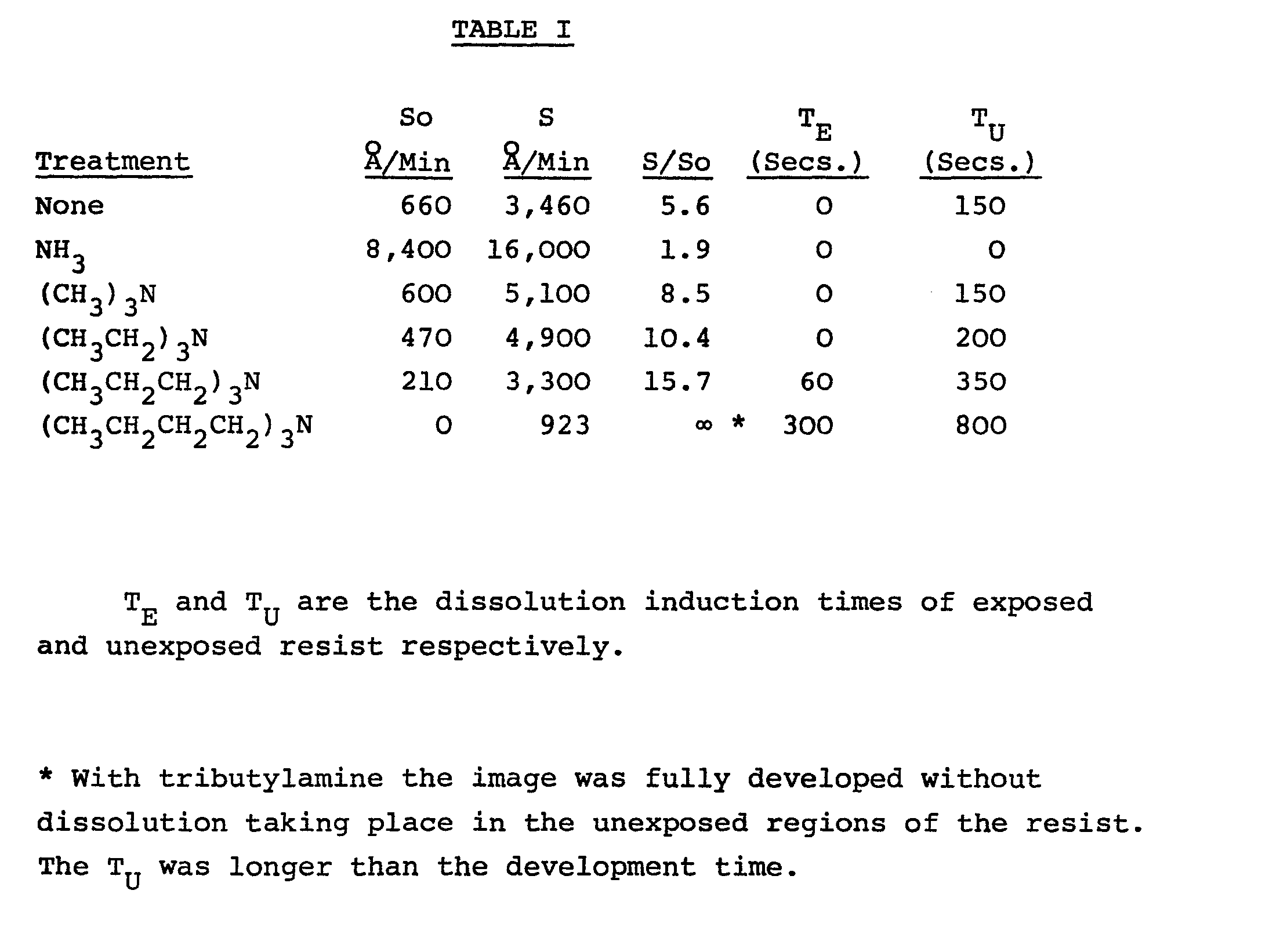| (19) |
 |
|
(11) |
EP 0 002 105 A1 |
| (12) |
EUROPEAN PATENT APPLICATION |
| (43) |
Date of publication: |
|
30.05.1979 Bulletin 1979/11 |
| (22) |
Date of filing: 13.10.1978 |
|
| (51) |
International Patent Classification (IPC)2: G03F 7/08 |
|
| (84) |
Designated Contracting States: |
|
DE FR GB SE |
| (30) |
Priority: |
23.11.1977 US 854440
|
| (71) |
Applicant: International Business Machines
Corporation |
|
Armonk, N.Y. 10504 (US) |
|
| (72) |
Inventors: |
|
- Carothers, James Albert
San José, California 95122 (US)
- Economy, James
San Jose
California 95120 (US)
- Ouano, Augustus Ceniza
San Jose
California 95123 (US)
|
| (74) |
Representative: Chaudhry, Mohammad Saeed |
|
IBM United Kingdom Patent Operations
Hursley Park
Winchester
Hants, S021 2JN
Winchester
Hants, S021 2JN (GB) |
|
| |
|
| (54) |
Process for increasing the solubility rate ratio of a positive-working resist |
(57) This invention relates to a process for increasing solubility rate ratio or shortening
the development time of quinone-diazo or quinone-triazo sensitized phenolic-aldehyde
resins. In accordance with the present invention, the resists are contacted with a
trialkylamine containing from two to eight carbon atoms in each alkyl group. This
process increases the ratio between the rate at which the exposed region of the resist
is dissolved and the rate at which the unexposed region is dissolved.
|
|
[0001] The present invention relates to a process for increasing the solubility rate ratio
or shortening the development time of quinone-diazo or quinone-triazo sensitized phenolic-aldehyde
resins.
[0002] According to the present invention there is provided a process for increasing the
solubility rate ratio of a quinone-diazo or quinone-triazo sensitized phenolic-aldehyde
resist, characterised in that the resist is contacted with a liquid trialkylamine
containing from two to eight carbon atoms in each alkyl group.
[0003] The expression "solubility rate ratio" refers to the ratio between the rate at which
the exposed region of the resist is dissolved and the rate at which the unexposed
region is dissolved.
[0004] The resist may be contacted with the amine either before or after the resist has
been exposed to radiation. It is, however, preferred that the contacting take place
after the irradiation, because in cases where it takes place before the exposure,
traces of residual amine may remain and be an undesired contaminant during the irradiation
step.
[0005] The optimum time of contact between the amine and the resist will vary with the depth
of etch profile desired. In general, a contact time of from about one minute to about
30 minutes is best. It is advantageous to use very high purity amine. The process
should preferably be carried out under anhydrous conditions.
[0006] The following example is given solely for purposes of illustration and is not to
be considered limitation on the invention.
[0007] Photo or electron beam resist material of the type described above is coated on a
substrate, i.e., 1 to 3 pm thick resist on silicon wafers by spin coating technique.
The coated wafers are then baked at ca. 85° C. to 95° C. for thirty minutes. After
baking, the wafers are exposed to light through a mask, which defines the patterns
desired, or to an electron beam. The exposed wafers are subsequently immersed in a
bath of the trialkylamine for the desired length of time (1 to 30 minutes) depending
on the thickness of the resist, the trialkylamine used and the desired profile of
the developed pattern. After soaking the exposed resist, it is spun dried for ca.
one minute and immediately developed in an appropriate developer which is either aquous
potassium hydroxide solution of approximately 0.25 normal concentration or a highly
buffered sodium hydroxide sodium silicate water solution for a desired length of time
which depends on the image profile desired, the type trialkylamine used and the intensity
of exposure.
[0008] The results are shown below in Table I. For controls, experiments are shown with
no treatment, with ammonia treatment, and with trimethylamine treatment. As can be
seen from the table, treatment with ammonia is actually harmful, and treatment with
trimethylamine produces very little result. On the other hand, treatment with the
amines of the present invention yields very beneficial results.

1. A process for increasing the solubility rate ratio of a quinone-diazo or quinone-triazo
sensitized phenolic-aldehyde resist, characterised in that the resist is contacted
with a liquid trialkylamine containing from two to eight carbon atoms in each alkyl
group.
2. A process as claimed in claim 1, wherein the amine is tributylamine.
3. A process as claimed in claim 1, wherein the amine is tripropylamine.
4. A process as claimed in any one of claims 1 to 3 wherein the resist is contacted
with said liquid trialkylamine for 1 to 30 minutes.
5. A process as claimed in any one of the preceding claims, wherein the resist is
contacted with said liquid trialkylamine after exposure of the resist to radiation.
6. A process as claimed in any one of the preceding claims, wherein the resist is
contacted with the liquid trialkylamine under anhydrous conditions.
